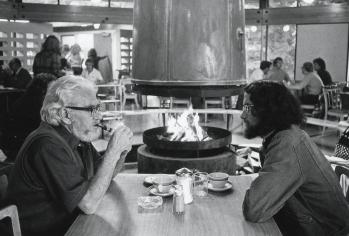

Nationally respected as a landscape artist, and influential in Saskatchewan as a teacher of art, Ernst Lindner was born in Vienna, Austria, and immigrated to Saskatoon with his parents in 1926. He became a self-taught freelance commercial artist and illustrator and, despite having no formal art education, eventually became Head of the Art Department at the Saskatoon Technical Collegiate (1936-62). Lindner's fame is largely derived from a substantial body of watercolour paintings examining the arboreal landscape near his Emma Lake summer home. Unique in that he abandons the horizon line traditional in the landscape genre, Lindner focuses instead on detailing the forest floor close up; here he depicts a highly textured glittering scatter of patterns resulting from the surface details of fallen branches and decomposing tree trunk stumps, all overgrown with fresh mosses and lichen. His microscopic fidelity has prompted some critics to label him a “magic realist.” More than this, though, his interests in patterning, in undifferentiated compositions, and in the painterly question of surface versus illusory depth situate him more broadly as a late Modernist.
Indeed, Lindner was influenced by several of the great New York modern painters of the late 1950s and early 1960s, with whom he came into contact when they were invited to be occasional guest artists at the Emma Lake Workshops. Of particular note, when examining Lindner's work, is formalist Jules Olitski, famous for his ethereal colour-field abstractions. Like the early American transcendentalist writers Walt Whitman, Ralph Waldo Emerson and Henry David Thoreau, Lindner revels in an almost mystical nature, revealing the big within the small by locating the specific within the whole: his visual meditations on nature's decay and renewal at the microcosmic level metaphorically encode macrocosmic issues related to universal notions of generation and regeneration. Lindner himself has spoken elsewhere of “my belief in a continuity of life, death being only another form of life… Life revealed in the smallest growth is, to me, most meaningful. Forms change, life goes on.”
Lindner was exhibited extensively throughout Canada during his lifetime. His work is held in over twenty-five major public and private collections across the country, including the National Gallery of Canada. The subject of numerous books, monographs and exhibition catalogues as well as the recipient of many awards, he received an Honorary Doctor of Laws degree from the University of Saskatchewan in 1972, was elected a member of the Royal Canadian Academy of the Arts in 1977, was made a Member of the Order of Canada in 1979, and was awarded the Saskatchewan Arts Board's Lifetime Award for Excellence in the Arts in 1988.
Jack Anderson